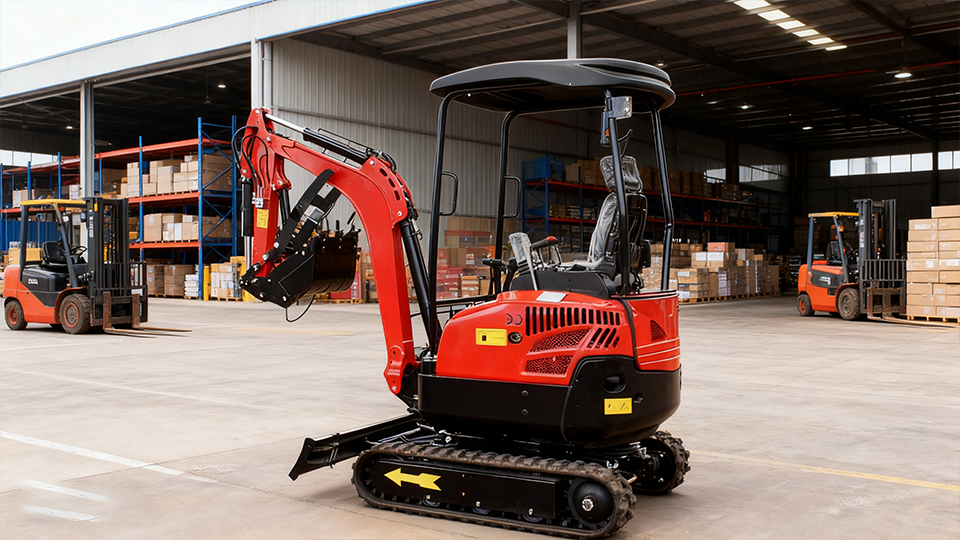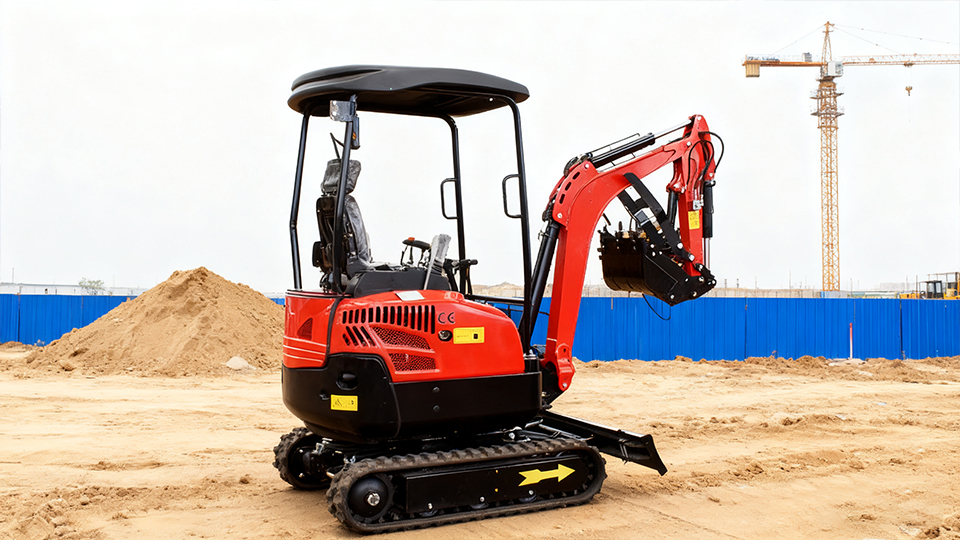Technical Article: Which Excavator Brand Dealerships Provide the Best After-Sales Service When Buying New?
The True Cost of Ownership: An In-Depth Analysis of After-Sales Service in the Excavator Market
Introduction: The Criticality of Uptime
In the competitive world of heavy construction, an excavator's initial purchase price is merely the entry fee. The true profitability of the machine, measured over its lifespan, hinges on its uptime—the amount of time it spends working versus waiting for repair. This metric is directly controlled by the quality and efficiency of the manufacturer's after-sales support system. For a new machine buyer, securing a partnership with a dealership that offers superior after-sales service is arguably the single most important long-term investment.
This technical article provides an in-depth analysis of the after-sales support networks for major global excavator manufacturers, focusing on the key performance indicators (KPIs) that directly impact a contractor's bottom line: Dealer Network Scope, Service Response Time, Parts Availability, and Advanced Telematics for Proactive Maintenance. We will examine the industry leaders—Caterpillar, Komatsu, Volvo, John Deere, and Hitachi—to determine which brand, on a dealership-by-dealership basis, offers the most robust and financially sound support ecosystem for new excavator buyers in the current market.
I. Defining Best-in-Class After-Sales Service
Evaluating after-sales service requires moving beyond anecdotal evidence and focusing on measurable, repeatable performance. The best service models are characterized by:
Minimizing Mean Time To Repair (MTTR): The time from equipment failure to its return to operational status.

Maximizing First-Time Fix Rate (FTFR): The percentage of repairs successfully completed on the initial technician visit, which heavily depends on technician expertise and mobile parts inventory.
Predictive Diagnostics: Leveraging telematics to identify and address potential failures before they occur, converting unplanned downtime into scheduled maintenance.
The following sections analyze how the top manufacturers structure their dealer support to meet these critical goals.
II. Global Giants: Caterpillar and Komatsu
Caterpillar (Cat) and Komatsu, the two largest heavy equipment manufacturers globally, are often seen as the benchmark for after-sales support due to their sheer scale and long-established networks.
A. Caterpillar (Cat): The Power of the Dealer Network
Caterpillar’s after-sales strength is rooted in its highly decentralized, yet globally consistent, network of independent dealerships.
Dealer Network and Field Service: Cat boasts the industry's most extensive and densely mapped dealer network worldwide. For a new machine buyer, this translates to geographical ubiquity, meaning a higher probability of having a well-staffed, full-service branch closer to any job site. This expansive reach is critical for fast Field Service Response.
Parts Availability: Cat dealers typically maintain massive local and regional inventories of OEM parts. Specific Cat dealer programs, such as service response guarantees, often promise core maintenance parts by the end of the next business day, or repair parts within two business days, backed by a financial credit for non-compliance. This commitment to reducing "waiting-for-parts" downtime is a significant competitive advantage (Snippet 4.1).
Advanced Telematics (Cat LINK™): The Cat LINK system provides advanced telematics for condition monitoring. The dealer uses this data for Predictive Maintenance—proactively scheduling service calls based on fault codes and fluid analysis, thus preventing catastrophic, unplanned failures. This remote diagnostic capability (Snippet 4.1) allows the technician to arrive with the correct parts and tools, significantly improving the FTFR.
B. Komatsu: Technology-Driven Support
Komatsu has heavily invested in technology to streamline its support model, focusing on efficiency and preventative care to reduce the Total Cost of Ownership (TCO).
Service Focus: Komatsu excavators are renowned for their fuel efficiency and design features aimed at reduced maintenance costs over the long term (Snippet 1.6). Their after-sales philosophy centers on preventing downtime rather than just reacting to it.
Telematics (KOMTRAX): Komatsu’s KOMTRAX system is a mandatory, integrated feature on their excavators. It provides comprehensive, real-time data on machine health, fuel consumption, and operational hours. The dealer leverages this data to perform more accurate, condition-based maintenance and remote diagnostics, a key factor in keeping the machine running efficiently.
Dealer Network Caveat: While the quality of Komatsu's support is high, the overall dealer network density is not as expansive as Caterpillar's in all global regions (Snippet 2.3). For contractors operating in remote or geographically challenging areas, a thorough pre-purchase assessment of the local Komatsu dealer's coverage and service fleet size is essential.
III. The Specialty Brands: Volvo, Hitachi, and John Deere
These brands compete by specializing in specific performance metrics, with their after-sales service models often tailored to these strengths.
A. Volvo Construction Equipment (CE): Service for Longevity and Safety
Volvo positions itself as a premium brand known for operator comfort, safety, and fuel-efficient operation. Their service offerings are designed to capitalize on the longevity of their components.
Service Network Strength: Volvo has a well-regarded and growing dealer network (Snippet 3.4). They are noted for strong support that helps extend machine life, which contributes to their reputation for good resale value (Snippet 1.2).

Proactive Maintenance: Volvo's machines are designed for high fuel efficiency, which often translates to fewer engine-related issues. The dealer focus is on maintaining the machine's complex hydraulic and technological systems, which are integral to their performance. Their dealer network is generally considered "strong" with good support (Snippet 3.4).
Parts Availability Challenge: A noted challenge for Volvo, especially for older models, has been that parts availability can sometimes be limited, which can negatively impact MTTR (Snippet 3.4). However, their newer, common platforms are improving this.
B. Hitachi Construction Machinery: Reliability and Collaborative Support
Hitachi excavators are prized for their reliability, durability, and sophisticated hydraulic systems (Snippet 3.2). Their after-sales support in the North American market is strongly influenced by a strategic partnership.
John Deere Collaboration: In North America, Hitachi often partners with John Deere dealers. This collaborative approach means that in regions with a strong John Deere presence, new Hitachi buyers benefit from a ready-made support infrastructure, including a comprehensive dealer and service network (Snippet 3.4).
Telematics (ConSite): Hitachi's ConSite fleet management system provides a comprehensive, digital solution for remote monitoring, sending daily summaries of machine health to the dealer and the customer. This commitment to transparency and proactive diagnostics helps ensure that the brand’s reputation for reliability is maintained in the field (Snippet 3.5).
Service Consistency: The quality of Hitachi's after-sales service is reliable, with a strong focus on technical expertise to manage their advanced hydraulic systems. However, the service experience can vary depending on the strength and geographical coverage of the specific dealer in question, particularly outside of the joint venture territories (Snippet 3.4).
C. John Deere: Comprehensive US-Centric Support
John Deere leverages its vast, long-standing dealer network, particularly in North America, to offer exceptionally strong customer support.
Customer Service and Network: John Deere is widely recognized for excellent customer service and a highly extensive dealer network with strong parts availability (Snippet 3.4). For general contractors and those operating primarily in rural or widespread regions, the density of the John Deere network provides a significant advantage in rapid field service deployment.
Telematics Integration: Their advanced telematics systems enable efficient fleet management and preventative diagnostics. This seamless integration of technology with their established service network ensures that strong customer support is built into the total ownership experience (Snippet 3.5).
Model Diversity: With a diverse range of equipment, their dealers are well-versed in supporting a variety of equipment sizes, from compact mini-excavators up to larger earthmoving units.
IV. Emerging Contenders: Hyundai, SANY, and XCMG
The newer entrants in the market, often originating from China or Korea, are heavily competing on initial purchase price and are now aggressively building out their after-sales support to address contractor concerns about long-term reliability.
Hyundai (HD Hyundai): Hyundai is focusing heavily on parts availability to reduce downtime. They have publicized high Fill-Up Rates (e.g., 98%) and a commitment to competitive parts pricing (Snippet 4.3). The recent opening of new parts distribution centers is a direct investment in reducing MTTR and boosting service confidence for new buyers (Snippet 4.3). They are an attractive option for contractors seeking reliable support on an affordable machine (Snippet 1.2).
SANY and XCMG: These Chinese manufacturers are making significant strides in build quality and technology (Snippet 1.2, 1.4). While their dealer and support networks are rapidly expanding, they are not yet as uniformly mature or dense as the established global players. For new buyers, after-sales service is the primary area of due diligence; it is crucial to vet the specific local dealer's service capacity, parts inventory, and technician training before committing to a purchase.
V. Key Performance Indicators (KPIs) for the New Buyer
The "best" dealership is regional, but the best brands are those that empower their dealers with a superior global support structure. A new excavator buyer must perform a localized assessment based on the following brand-driven support KPIs:
After-Sales KPI Best-Performing Brands Technical Value Proposition for the Contractor
Dealer Network Density Caterpillar, John Deere Fastest Field Service Response Time (MTTR) and lower mileage charges for mobile service.
Parts Availability Caterpillar, Hyundai, John Deere Guaranteed next-day parts delivery with financial credit for delays (Cat); high domestic Fill-Up Rates (Hyundai).
Telematics & Remote Diagnostics Komatsu (KOMTRAX), Caterpillar (Cat LINK), Hitachi (ConSite) Predictive Maintenance capability; higher First-Time Fix Rate (FTFR) by ensuring the technician arrives with the right tools/parts.
Cost of Maintenance Komatsu, Hitachi, Hyundai Fuel-efficient engines and reliable designs lead to lower long-term operating costs and less frequent servicing.
Comprehensive Dealer Coverage Volvo, John Deere Strong, localized dealer support network with dedicated technicians for specialized models.
Conclusion: The Dealership is the Deciding Factor
While brands like Caterpillar and Komatsu provide the gold standard in a globally consistent, technology-enabled support infrastructure, the ultimate quality of the after-sales experience resides in the individual dealership.
Caterpillar leverages its unparalleled network density and guaranteed parts programs to provide the highest confidence in maximizing uptime.
Komatsu stands out for its deep integration of technology (KOMTRAX) to drive proactive, preventative maintenance, which significantly reduces the Total Cost of Ownership (TCO).
John Deere offers a highly accessible, customer-focused service model, particularly robust in North America.
For a contractor purchasing a new excavator, the prudent strategy is to identify the leading brands for service (Cat, Komatsu, and John Deere being the strongest contenders) and then conduct a thorough due diligence on the local dealer. This includes interviewing the dealership’s Service Manager, reviewing their field service vehicle count, verifying their parts warehouse inventory levels, and securing a clear, contractual agreement on response times and parts delivery guarantees. The decision to buy a new excavator is a multi-year partnership with the service department, and the strength of that partnership directly dictates the long-term success of the equipment investment.
Post time:Sep-25-2020
